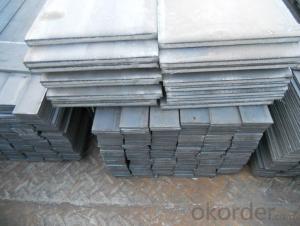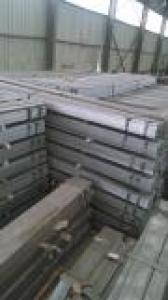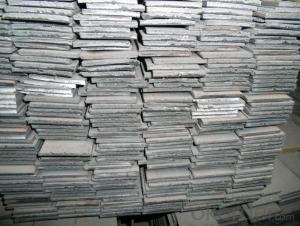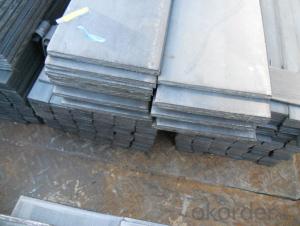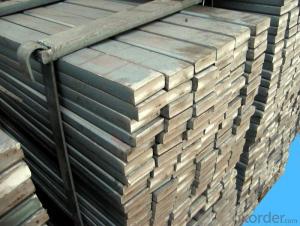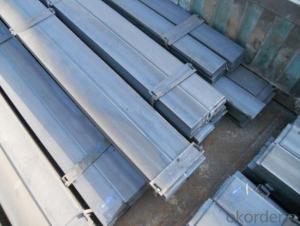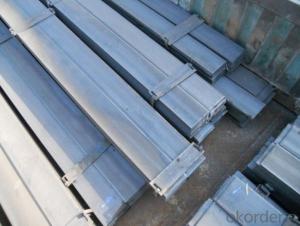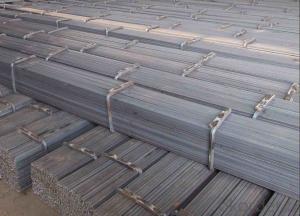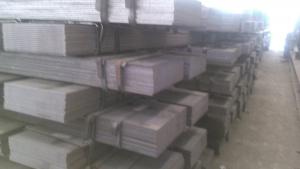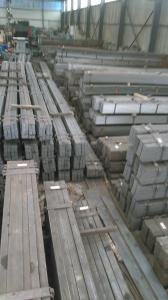Standard Size Q235 Hot Rolled Steel Flats from China
- Loading Port:
- China main port
- Payment Terms:
- TT or LC
- Min Order Qty:
- 50 m.t.
- Supply Capability:
- 200000 m.t./month
OKorder Service Pledge
OKorder Financial Service
You Might Also Like
Details of Standard Size Q235 Hot Rolled Steel Flats from China
| Minimum Order Quantity: | 25MT | Unit: | m.t. | Loading Port: | China Main Port |
| Supply Ability: | 80000-100000MTS/YEAR | Payment Terms: | TT or LC |
Specification of Standard Size Q235 Hot Rolled Steel Flats from China
Commodity: Q235 Steel Flat Bar
Standard: GB
Material: Q235
Brand name: FLATSPACE
Origin place: China
Thickness: 3mm-30mm
Width:20mm-200mm
Length: Max 12m
Certification: SGS/BV
Chemical composition of Standard Size Q235 Hot Rolled Steel Flats from China
Alloy No | Grade | Element(%) | ||||
C
| Mn
| S
| P
| Si
| ||
Q235
|
B
|
0.12—0.20 |
0.3—0.7 |
≤0.045 |
≤0.045
|
≤0.3
|
Physical properties of Standard Size Q235 Hot Rolled Steel Flats from China
Alloy No | Grade | Yielding strength point(Mpa) | Tensile strength (Mpa) | Elongation after fracture(%) | ||||||
Thickness (mm) | Thickness (mm) | |||||||||
≤16 | >16--40 | >40--60 | >60--100 |
| ≤16 | >16--40 | >40--60 | >60--100 | ||
≥ | ≥ | |||||||||
Q235 |
B |
235 |
225 |
215 |
205 |
375--500 |
26 |
25 |
24 |
23 |
Usage/Applications of Standard Size Q235 Hot Rolled Steel Flats from China
Widely used for construction, Machinery manufacturing, Iron tower steel structure, Shipbuilding; Steel grating, Staircase, Bridge, Viaduct, Railway spare parts, Boilers making etc.
Production Flow of Standard Size Q235 Hot Rolled Steel Flats from China
The steel flat bar is made through three processes:
1.Feeding the material: Feeding the row material (the steel plate) to Slitting Line.
2.Slitting:The steel plate would be slitted into expected width by lengthways cutter.
3. Leveled and cutting: The plat bar would be ground into level by the grinder and then cut into required length.
Packaging & Delivery of Standard Size Q235 Hot Rolled Steel Flats from China
Packaging Details: The Steel Flat Bars are packed in bundles and loaded in 20 feet/40 feet container, or shipped by bulk cargo ,also we can do as customer's requirements.
Delivery Details:30~45 days upon the receipt of buyer payment by T.T. or L/C.
Pictures of Standard Size Q235 Hot Rolled Steel Flats from China

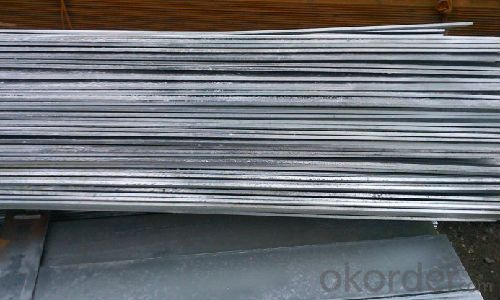
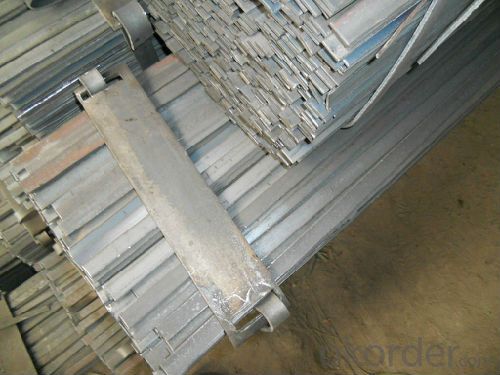
- Q: Can steel flat bars be used for making conveyor systems?
- Yes, steel flat bars can be used for making conveyor systems. Steel flat bars are known for their strength, durability, and resistance to corrosion, making them an ideal choice for conveyor systems that need to handle heavy loads and withstand constant use. The flat shape of the bars allows for easy attachment of rollers or other components, making it easier to assemble and customize the conveyor system. Additionally, steel flat bars can be easily welded or bolted together, providing flexibility in designing and constructing conveyor systems of various sizes and configurations.
- Q: Can steel flat bars be painted or powder-coated?
- Yes, steel flat bars can be painted or powder-coated. Painting or powder-coating steel flat bars can provide protection against corrosion, enhance their appearance, and allow for customization. Prior to painting or powder-coating, the surface of the steel flat bars should be properly prepared by removing any rust, dirt, or oil. This can be done through cleaning, sanding, or using a primer. Once the surface is prepared, a suitable paint or powder coating can be applied. This process will ensure that the steel flat bars are protected and have a durable and aesthetically pleasing finish.
- Q: Can steel flat bars be used for making security gates?
- Absolutely! When it comes to crafting security gates, steel flat bars are an ideal choice. Steel, renowned for its durability and strength, offers exceptional security and protection. Notably, flat bars can be effortlessly welded or bolted together, enabling the creation of a robust gate structure. Furthermore, steel flat bars possess corrosion resistance and can endure harsh weather conditions, rendering them perfect for outdoor applications. By employing steel flat bars, security gates can be constructed to deliver a top-notch level of security, guaranteeing the safety of any property or premises.
- Q: Can steel flat bars be used for making stair treads or steps?
- Stair treads or steps can indeed be made using steel flat bars. The robustness and durability of steel make it an excellent choice for providing stability and support to staircases. By conveniently fabricating and molding flat bars, one can effortlessly fashion treads or steps that are not only functional but also visually appealing. Moreover, steel's ability to resist corrosion renders it suitable for outdoor or heavily frequented locations where stairs are typically found. Nevertheless, it is crucial to carefully deliberate on the thickness and dimensions of the steel flat bars to guarantee their ability to endure the anticipated weight and fulfill the essential safety requirements.
- Q: Can steel flat bars be used for elevator shafts or doors?
- Indeed, elevator shafts or doors can utilize steel flat bars. The strength and durability of steel flat bars make them a common choice for construction and fabrication projects. When it comes to elevator shafts and doors, it is crucial to employ materials that can withstand heavy loads, offer structural integrity, and ensure passenger safety. Steel flat bars possess these desirable characteristics, which is why they are frequently employed in the construction of elevator shafts and doors. By fabricating and welding them, the necessary framework and support for elevator systems can be created. Moreover, steel flat bars can be coated or treated to increase their resistance to corrosion, rendering them suitable for both interior and exterior elevator applications.
- Q: Can steel flat bars be used for making storage cabinets?
- Yes, steel flat bars can be used for making storage cabinets. Steel flat bars are sturdy and durable, making them suitable for constructing storage cabinets that can withstand heavy loads. They offer excellent structural integrity and can be easily welded or bolted together to create a stable and secure storage solution. Additionally, steel flat bars are resistant to rust and corrosion, ensuring the longevity of the storage cabinets. Therefore, using steel flat bars for making storage cabinets is a practical choice that can provide strength, durability, and a professional appearance.
- Q: Are steel flat bars suitable for making furniture or fixtures?
- Yes, steel flat bars are suitable for making furniture or fixtures. They are strong, durable, and provide a modern and industrial aesthetic. They can be easily manipulated and welded to create various shapes and designs for furniture or fixtures.
- Q: How do you prevent scaling or oxidation on steel flat bars during heat treatment?
- To prevent scaling or oxidation on steel flat bars during heat treatment, a common approach is to use a protective atmosphere or medium such as nitrogen or controlled atmosphere furnaces. Additionally, applying a coating or using stainless steel or heat-resistant alloys can help prevent scaling or oxidation. Employing proper handling techniques, such as avoiding exposure to moisture or corrosive substances, can also contribute to minimizing scaling or oxidation during heat treatment.
- Q: What are the safety considerations when working with steel flat bars?
- When working with steel flat bars, important safety considerations include wearing appropriate personal protective equipment (PPE) such as gloves, safety glasses, and steel-toed boots to protect against potential injuries from sharp edges or falling bars. It is crucial to ensure that the work area is well-ventilated and free from any flammable materials as sparks generated during cutting or welding processes can pose fire hazards. Additionally, proper handling techniques should be followed to avoid strains or injuries, and using appropriate tools and equipment, such as clamps or vices, can help stabilize the bars and minimize the risk of accidents.
- Q: What is the minimum order quantity for steel flat bars?
- The minimum order quantity for steel flat bars may differ depending on the supplier or manufacturer. Various factors, such as production costs, transportation logistics, and customer demand, typically determine the minimum order quantity. However, it is not unusual to encounter minimum order quantities that range from 1 to 10 metric tons. It is recommended to get in touch with the particular supplier or manufacturer to inquire about their minimum order requirements and negotiate accordingly.
Send your message to us
Standard Size Q235 Hot Rolled Steel Flats from China
- Loading Port:
- China main port
- Payment Terms:
- TT or LC
- Min Order Qty:
- 50 m.t.
- Supply Capability:
- 200000 m.t./month
OKorder Service Pledge
OKorder Financial Service
Similar products
Hot products
Hot Searches
Related keywords
